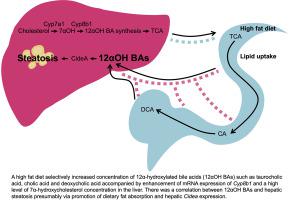The Journal of Nutritional Biochemistry ( IF 4.8 ) Pub Date : 2020-05-20 , DOI: 10.1016/j.jnutbio.2020.108412 Shota Hori 1 , Takayuki Abe 1 , Dong Geun Lee 1 , Satoru Fukiya 1 , Atsushi Yokota 1 , Nao Aso 2 , Bungo Shirouchi 2 , Masao Sato 2 , Satoshi Ishizuka 1

|
High-fat (HF) diet induces hepatic steatosis that is a risk factor for noncommunicable diseases such as obesity, type 2 diabetes and cardiovascular disease. Previously, we found that HF feeding in rats increases the excretion of fecal bile acids (BAs), specifically 12α-hydroxylated (12αOH) BAs. Although the liver is the metabolic center in our body, the association between hepatic steatosis and 12αOH BAs in HF-fed rats is unclear. Thus, we investigated extensively BA composition in HF-fed rats and evaluated the association between hepatic steatosis and 12αOH BAs. Acclimated male inbred WKAH/HkmSlc rats were divided into two groups and fed either control or HF diet for 8 weeks. Feeding HF diet increased hepatic triglyceride and total cholesterol concentrations, which correlated positively with 12αOH BAs concentrations but not with non-12αOH BAs in the feces, portal plasma and liver. Accompanied by the increase in 12αOH BAs, the rats fed HF diet showed increased fat absorption and higher mRNA expression of liver Cidea. The enhancement of 12αOH BA secretion may contribute to hepatic steatosis by the promotion of dietary fat absorption and hepatic Cidea mRNA expression. The increase in 12αOH BAs was associated with enhanced liver cholesterol 7α-hydroxylase (Cyp7a1) and sterol 12α-hydroxylase (Cyp8b1) mRNA expression. There was a significant increase in 7α-hydroxycholesterol, a precursor of BAs, in the liver of HF-fed rats. Altogether, these data suggest that the HF diet increases preferentially 12αOH BAs synthesis by utilizing the accumulated hepatic cholesterol and enhancing mRNA expression of Cyp7a1 and Cyp8b1 in the liver.
中文翻译:

高脂饮食大鼠的12α-羟基化胆汁酸与肝脂肪变性的关系。
高脂(HF)饮食会引起肝脏脂肪变性,这是非传染性疾病(例如肥胖症,2型糖尿病和心血管疾病)的危险因素。以前,我们发现大鼠进食HF会增加粪便胆汁酸(BAs)的排泄,特别是12α-羟基化(12αOH)BAs的排泄。尽管肝脏是我们体内的代谢中心,但尚不清楚HF喂养的大鼠中肝脂肪变性与12αOHBA之间的关系。因此,我们广泛研究了HF喂养大鼠的BA组成,并评估了肝脂肪变性和12αOHBA之间的关系。将适应的雄性近交WKAH / HkmSlc大鼠分为两组,并以对照或HF饮食喂养8周。进食HF饮食会增加肝甘油三酸酯和总胆固醇的浓度,与粪便,门脉血浆和肝脏中的12αOHBAs浓度呈正相关,而与非12αOHBAs呈正相关。伴随着12αOHBAs的增加,用HF饮食的大鼠表现出增加的脂肪吸收和较高的肝脏mRNA表达Cidea。12αOHBA分泌的增加可能通过促进饮食脂肪吸收和肝Cidea mRNA表达而促进肝脂肪变性。12αOHBAs的增加与肝脏胆固醇7α-羟化酶(Cyp7a1)和固醇12α-羟化酶(Cyp8b1)mRNA表达增加相关。在HF喂养的大鼠的肝脏中,BAs的前体7α-羟基胆固醇显着增加。总之,这些数据表明HF饮食通过利用积累的肝胆固醇并增强肝脏中Cyp7a1和Cyp8b1的mRNA表达来优先增加12αOHBAs的合成。











































 京公网安备 11010802027423号
京公网安备 11010802027423号